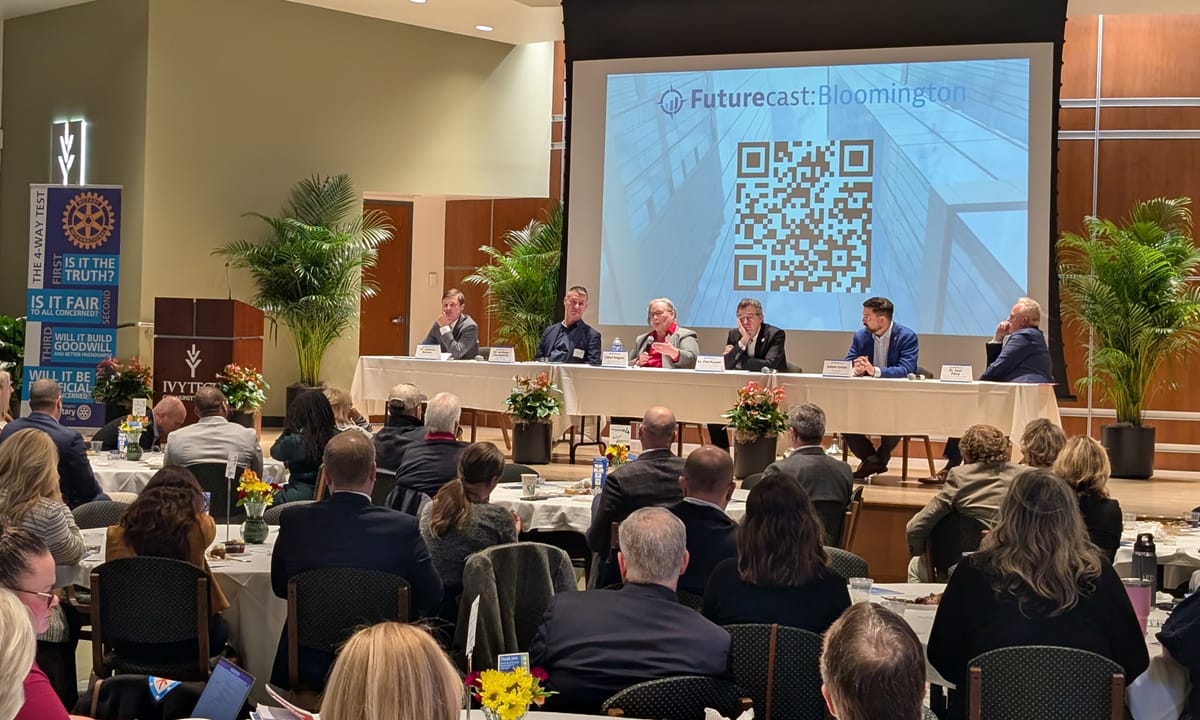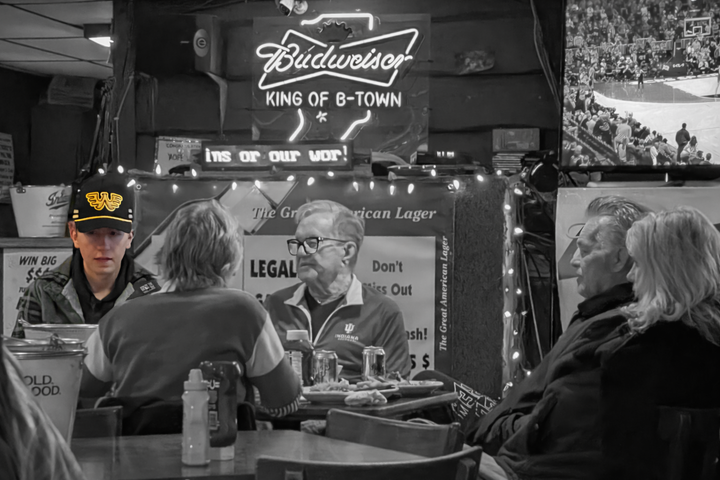IU Kelley School panelist drops ‘rough‘ news about Bloomington wages, points to Trades District as site of ‘creative collision‘
At IU’s Futurecast Economic Outlook in Bloomington, Kelley School economist Phil Powell said the region’s wages fell 6.2% over the past year—among the worst in the state—due to IU job losses. Still, he praised local entrepreneurs and pointed to the Trades District as a hopeful hub for innovation.


On Tuesday (Nov. 4), the Kelley School of Business at Indiana University brought its Futurecast Economic Outlook to Bloomington. It was the second stop on a statewide tour of 11 Hoosier cites over the next three weeks.
Hosted at Ivy Tech Community College by the Greater Bloomington Chamber of Commerce and Bloomington Rotary, panelists for the Bloomington edition of Futurecast offered the assembled luncheon crowd of business and government leaders a broad economic forecast for 2026, with some attention paid to Bloomington’s unique challenges.
Of the panelists, Phil Powell, executive director of the Indiana Business Research Center at the Kelley School, focused the most on Bloomington specifically.
Powell prefaced his remarks about wages by saying, “Bloomington, folks, the news is rough.” Powell then sketched out the national and statewide picture for wages, between August of 2024 and August of 2025. On the national level, the average real earnings per hour, that is wages, went up by 3.7%, according to Powell. The state of Indiana, Powell reported, outpaced the rest of the country for the first time in a long while, with a 5.2% real earnings growth.
Then Powell dropped a hard fact: “Bloomington? Minus 6.2%.” That is, between August 2024 and August 2025 the metropolitan statistical area for Bloomington (Monroe and Owen counties) showed a 6.2% decrease in the average hourly earnings for workers. Powell was blunt: “Our region is really lagging the state.” Powell went as far as to rank Bloomington’s metropolitan statistical area “near the bottom in the state” based on the kind of year they’ve had so far in 2025.
Powell chalked up much of the real hourly earnings decrease to a decline in higher ed employment, at Indiana University—which is a key regional employer. Many high-paying jobs at Indiana University have either been downsized or not refilled, Powell said, which brought the average wage down.
Still, Powell found reason for some optimism, noting that the area’s private sector is showing “resilience.” He based that on the number of new businesses that have been established over grew 3.3% over the last year—outpacing state and national averages. Powell said, “God bless the main street businesses here in Bloomington. You are helping to cushion what are tough times in higher ed.”
Looking forward, Powell predicted muted growth for the region, saying, “If we get to 1% growth, it will have been a good year for Bloomington.” He concluded that while commercial projects like the Trades District and new life sciences investments bring hope, IU’s ongoing adjustments will be a defining challenge for the local workforce and economy.
The Trades District is a roughly 12-acre area located just northwest of Bloomington’s city hall, which was once part of the historic Showers Brothers furniture factory complex. It’s now part of a larger 65-acre technology park that is supposed to attract startups, creative firms, and research-driven companies in partnership with Indiana University, The Forge (3-story 22,000-square-foot technology center for companies past the startup phase) and The Mill (a coworking space operated by an eponymous nonprofit).
The Trades District is celebrating Innovation Week this week starting Tuesday (Nov. 4) culminating in a block party on Friday.
Powell pointed to the Trades District in response to a request from the audience for just one recommendation that could help Bloomington be more competitive—statewide, perhaps in the Midwest, or nationwide. Powell called the Trades District the “ultimate mixing of university research and commercialization.” About that combination, Powell said, “We haven’t had that in Bloomington before.” Essential for a university to drive economic development, Powell said, is a “single point of geography” where there is “creative collision,” and the Trades District is a place where that can now happen, Powell said.
Adam Gross, vice chancellor at Ivy Tech Bloomington, added that his school should be included in conversations about creative collisions, saying, “Whether you need workforce to bring in a new company, we’re here to support, we’ve got students that are looking for careers.”
Gross also broke a bit of light-hearted news at Tuesday’s event by unveiling the name of the mascot character for the school. The mascot had previously been announced as the B-Town Bees, but the name of the character was still unknown. Gross revealed at Tuesday’s event that the name will be “Hivey.”
Other panelists included: Andrew Butters, assistant professor at the Kelley School; Andreas Hauskrecht, business economics professor at Kelley; and Carol Rogers, director of the Indiana Business Research Center. Moderating the panel was Josh Perry, who is associated dean at Kelley.
Hauskrecht took a cautious view of AI saying, “It reminds me a little bit—for the ones of you are old enough, the early 2000s—[of] the tech bubble, and I’m not sure if this will all end in the way people are hoping.” Uncertainty is everywhere, Hauskrecht said, citing unpredictable interest rates, persistent inflation, and the potential perils of excessive government debt. About the debt, he said we are “kicking the can down the road” and called it “almost a generational fight,” adding, “We are having a party, and our kids have to pick up the bill.”
Eric Spoonmore, president of the Greater Bloomington Chamber of Commerce, welcomed attendees and thanked event sponsors. He highlighted the longstanding partnership between the chamber and the Rotary Club for bringing forward-looking economic conversations to the community.
The event opened with remarks by The Rotary Club’s Loren Snyder, who reflected on the value of democratic engagement, urging attendees to focus on what they can control, and to focus on having a positive impact in a nonpartisan way.
“Each of us can, instead of red or blue, choose to be the sunshine that brings a rainbow after a storm,” he said. Snyder kicked out with an exhortation: “Go be somebody’s rainbow today.”




Comments ()